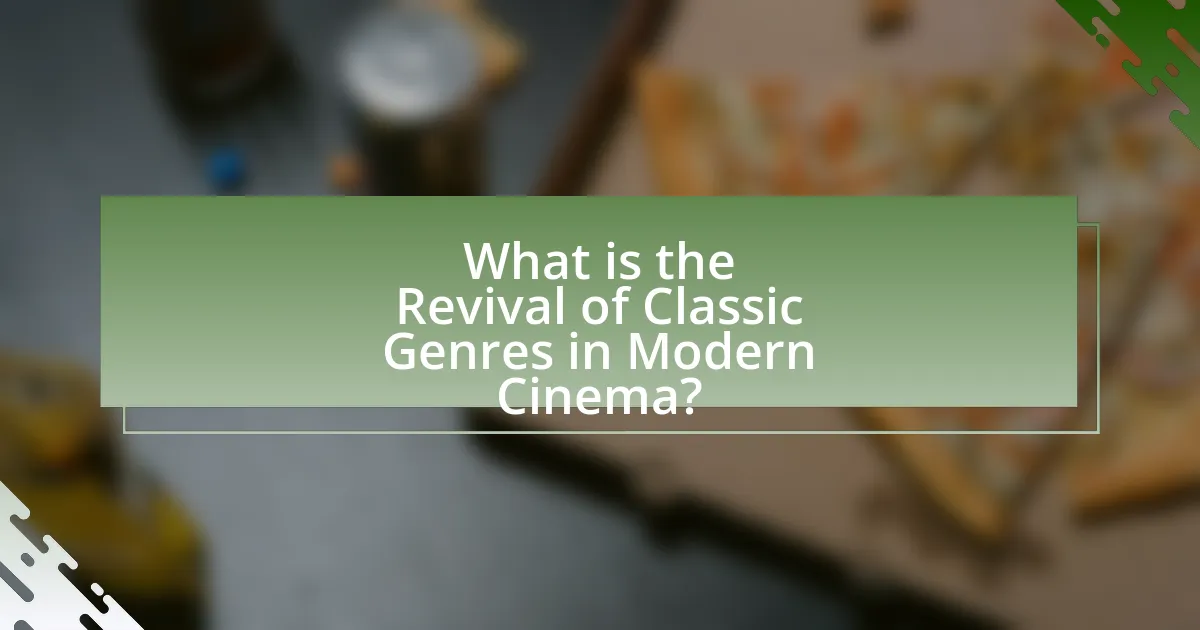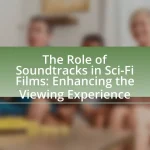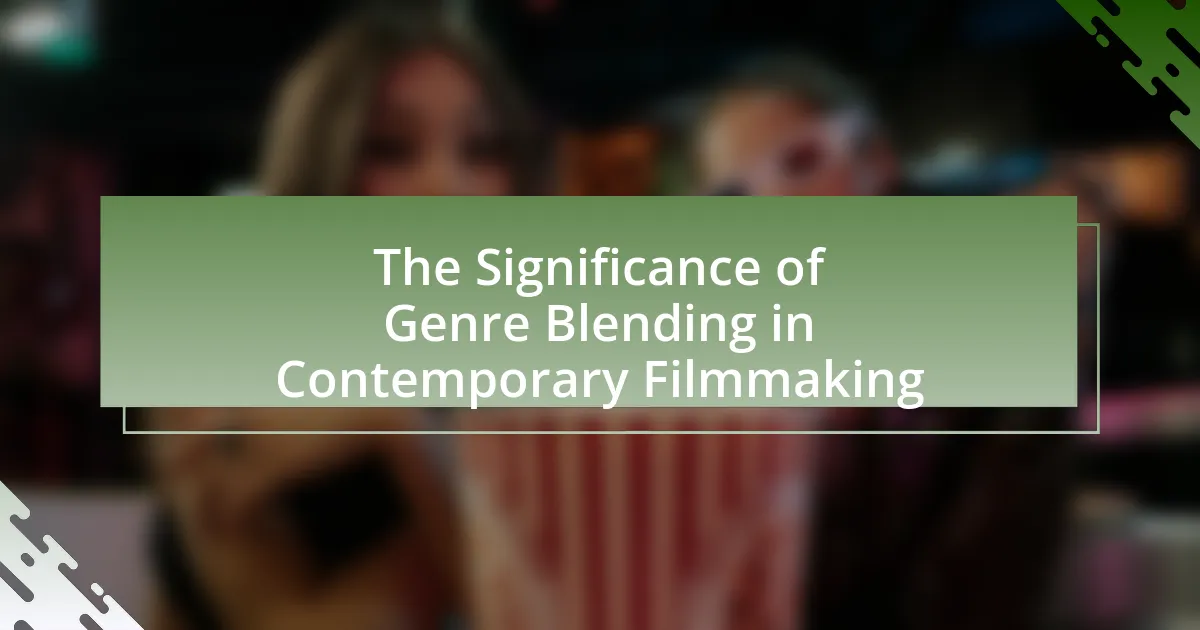The article examines the revival of classic genres in modern cinema, highlighting how filmmakers draw inspiration from earlier styles such as film noir, westerns, and musicals to create contemporary works that resonate with today’s audiences. It discusses the influence of nostalgia on audience engagement, the key genres experiencing a resurgence, and the techniques used to modernize classic narratives. Additionally, the article addresses the cultural significance of this revival, the challenges faced by filmmakers, and the strategies for successfully adapting classic genres while maintaining relevance in a rapidly changing media landscape.

What is the Revival of Classic Genres in Modern Cinema?
The revival of classic genres in modern cinema refers to the resurgence of filmmaking styles and themes that were prominent in earlier decades, such as film noir, westerns, and musicals. This trend is characterized by contemporary filmmakers drawing inspiration from these classic genres to create new works that resonate with today’s audiences while evoking nostalgia. For instance, films like “La La Land” (2016) pay homage to classic musicals, blending traditional elements with modern storytelling techniques. This revival is supported by box office successes and critical acclaim, indicating a strong audience appetite for familiar yet innovative cinematic experiences.
How does nostalgia influence the revival of classic genres?
Nostalgia significantly influences the revival of classic genres by creating a strong emotional connection between audiences and familiar cultural references. This emotional resonance drives consumer interest, as seen in the resurgence of 1980s and 1990s films and television shows, which often evoke fond memories for viewers. For instance, the success of reboots like “Stranger Things” and “Ghostbusters: Afterlife” demonstrates how nostalgia can attract both older audiences who experienced the originals and younger viewers discovering them for the first time. Research indicates that nostalgia can enhance enjoyment and engagement, making it a powerful marketing tool in the entertainment industry.
What are the key classic genres being revived today?
The key classic genres being revived today include horror, musicals, and westerns. Horror has seen a resurgence with films like “It” and “A Quiet Place,” which draw on classic horror tropes while incorporating modern storytelling techniques. Musicals have made a comeback with successful adaptations such as “The Greatest Showman” and “La La Land,” appealing to audiences with their nostalgic charm and contemporary themes. Westerns are also experiencing a revival, exemplified by projects like “The Harder They Fall,” which reimagines traditional narratives for a new generation. These revivals reflect a broader trend in cinema where filmmakers are blending nostalgia with innovation to attract diverse audiences.
How do filmmakers incorporate nostalgic elements into modern storytelling?
Filmmakers incorporate nostalgic elements into modern storytelling by utilizing visual styles, thematic motifs, and cultural references that evoke past eras. For instance, the use of retro aesthetics, such as 1980s color palettes and cinematography, can be seen in films like “Stranger Things,” which pays homage to the visual language of that decade. Additionally, filmmakers often weave in familiar tropes and character archetypes from classic genres, such as the coming-of-age narrative or the buddy cop dynamic, to create a sense of familiarity and comfort for audiences. This approach is supported by research indicating that nostalgia can enhance emotional engagement and audience connection, as noted in the study “Nostalgia: A Psychological Resource” by Wildschut et al., published in the Journal of Personality and Social Psychology. By blending these nostalgic elements with contemporary storytelling techniques, filmmakers effectively bridge the gap between past and present, appealing to both older and younger generations.
Why is the revival of classic genres significant in contemporary culture?
The revival of classic genres is significant in contemporary culture because it fosters a sense of nostalgia and connection to cultural heritage. This resurgence allows audiences to engage with familiar storytelling techniques and themes that resonate across generations, enhancing emotional engagement. For instance, the popularity of remakes and reboots, such as “A Star is Born” and “It,” demonstrates how classic narratives can be reinterpreted to reflect modern societal issues while maintaining their core essence. This trend not only revitalizes interest in older works but also stimulates discussions about cultural identity and artistic evolution, making classic genres relevant in today’s diverse media landscape.
What cultural factors contribute to the popularity of classic genres?
Cultural factors contributing to the popularity of classic genres include nostalgia, cultural identity, and the influence of media. Nostalgia drives audiences to seek familiar themes and styles that evoke positive memories, often leading to a resurgence in classic genres. Cultural identity plays a significant role, as these genres often reflect societal values and historical contexts that resonate with contemporary audiences. Additionally, the influence of media, including remakes and references in modern films, reinforces the appeal of classic genres by introducing them to new generations. For instance, the success of films like “Stranger Things” showcases how nostalgia for 1980s culture has revitalized interest in classic horror and adventure genres.
How does the revival reflect societal changes and trends?
The revival of classic genres in modern cinema reflects societal changes and trends by showcasing a collective yearning for familiarity and comfort amidst rapid technological and cultural shifts. This trend indicates a desire for nostalgia, as audiences increasingly seek connections to their past, which is evident in the resurgence of films that evoke earlier cinematic styles and themes. For instance, the popularity of remakes and reboots, such as “It” (2017) and “A Star is Born” (2018), demonstrates how filmmakers tap into established narratives that resonate with contemporary viewers, thereby reinforcing the notion that these stories still hold relevance. Additionally, the revival aligns with the rise of streaming platforms, which provide access to a vast library of classic films, further fueling interest in these genres and reflecting a broader cultural trend towards valuing heritage and tradition in an era of constant change.

What are the characteristics of modern adaptations of classic genres?
Modern adaptations of classic genres often feature updated themes, diverse representation, and innovative storytelling techniques. These adaptations frequently recontextualize traditional narratives to resonate with contemporary audiences, incorporating current social issues and cultural dynamics. For instance, films like “Little Women” (2019) and “The Great Gatsby” (2013) showcase modern feminist perspectives and multicultural elements, reflecting today’s societal values. Additionally, advancements in technology, such as CGI and streaming platforms, allow for more creative visual storytelling and broader accessibility, enhancing audience engagement with these reimagined classics.
How do modern adaptations differ from their original counterparts?
Modern adaptations differ from their original counterparts primarily in their thematic focus, cultural context, and character development. While original works often reflect the societal norms and values of their time, modern adaptations frequently reinterpret these elements to resonate with contemporary audiences. For instance, adaptations may introduce diverse characters or address current social issues, thereby enhancing relevance. A notable example is the 2019 adaptation of “Little Women,” which emphasizes female empowerment and independence, diverging from the more traditional portrayals in earlier versions. This shift illustrates how modern adaptations not only aim to entertain but also to provoke thought and discussion, aligning with current cultural dialogues.
What techniques are used to modernize classic narratives?
Techniques used to modernize classic narratives include recontextualization, character reinterpretation, and the incorporation of contemporary themes. Recontextualization involves placing classic stories in modern settings or altering their cultural context to resonate with today’s audience, as seen in adaptations like “West Side Story,” which updates “Romeo and Juliet” to a contemporary urban environment. Character reinterpretation focuses on giving traditional characters new backgrounds or motivations, exemplified by films like “Maleficent,” which reimagines the villain from “Sleeping Beauty” as a complex protagonist. Incorporating contemporary themes, such as social justice or technology, allows classic narratives to address current societal issues, as demonstrated in adaptations like “The Great Gatsby,” which highlights themes of wealth disparity relevant to modern audiences. These techniques effectively bridge the gap between classic literature and contemporary storytelling, making them relevant and engaging for today’s viewers.
How do visual and audio elements enhance the nostalgic experience?
Visual and audio elements significantly enhance the nostalgic experience by evoking memories and emotions associated with past eras. For instance, the use of retro color palettes and vintage cinematography in films can transport viewers back to specific time periods, triggering personal recollections. Similarly, audio elements such as soundtracks featuring iconic songs from the past or sound design that mimics older technologies can create an immersive atmosphere that resonates with audiences. Research indicates that nostalgia is often linked to sensory experiences; a study published in the journal “Psychological Science” found that music can evoke vivid memories and emotions, reinforcing the connection between audio cues and nostalgic feelings. Thus, the strategic incorporation of visual and audio elements in modern cinema effectively taps into collective and individual memories, enhancing the overall nostalgic experience.
What role do audiences play in the revival of classic genres?
Audiences play a crucial role in the revival of classic genres by driving demand for nostalgic content. Their preferences influence filmmakers and studios to revisit and reinterpret classic genres, as evidenced by the success of remakes and reboots that resonate with contemporary viewers. For instance, the resurgence of interest in horror films, particularly those inspired by 1970s and 1980s classics, has led to box office successes like “It” and “Halloween,” which grossed over $700 million and $250 million respectively. This financial success demonstrates that audience engagement with classic themes and styles can significantly impact production decisions, leading to a cycle of revival that capitalizes on nostalgia while attracting new generations of viewers.
How do audience preferences shape the direction of modern adaptations?
Audience preferences significantly shape the direction of modern adaptations by influencing the themes, characters, and narratives that creators choose to explore. For instance, the resurgence of interest in nostalgic content, such as remakes of classic films and reboots of beloved franchises, reflects a desire for familiarity and comfort among viewers. This trend is supported by box office successes of adaptations like “It” and “Stranger Things,” which capitalize on 1980s nostalgia, demonstrating that audiences are drawn to familiar stories reimagined for contemporary contexts. Additionally, streaming platforms analyze viewer data to tailor adaptations that align with audience tastes, further steering creative decisions. This data-driven approach ensures that adaptations resonate with current cultural sentiments, ultimately guiding the evolution of storytelling in modern cinema.
What impact does audience nostalgia have on box office success?
Audience nostalgia significantly enhances box office success by driving viewer interest and engagement. Films that evoke nostalgia often tap into familiar themes, characters, or aesthetics that resonate with audiences, leading to increased ticket sales. For instance, the 2017 release of “It,” based on Stephen King’s novel, generated over $700 million globally, largely due to its appeal to those who grew up with the original story and its 1990 miniseries adaptation. Additionally, research from the Journal of Consumer Research indicates that nostalgia can create a positive emotional response, which in turn influences purchasing decisions, including movie tickets. This emotional connection can lead to repeat viewings and strong word-of-mouth promotion, further boosting box office performance.

What are the challenges faced in reviving classic genres?
Reviving classic genres faces several challenges, primarily due to shifting audience preferences and cultural relevance. Audiences today often seek innovative storytelling and diverse representation, which can clash with the conventions of classic genres that may feel outdated or less inclusive. Additionally, filmmakers encounter the difficulty of balancing nostalgia with originality; they must honor the essence of the classic while also providing fresh perspectives to engage modern viewers. Financial constraints also play a role, as studios may be hesitant to invest in projects that do not guarantee box office success, particularly when the classic genre may not resonate with younger demographics. Historical context is crucial, as many classic genres were products of their time, and adapting them for contemporary sensibilities requires careful consideration of social and cultural changes.
How do filmmakers balance innovation with tradition?
Filmmakers balance innovation with tradition by integrating contemporary storytelling techniques while respecting established genre conventions. This approach allows them to create fresh narratives that resonate with modern audiences, as seen in films like “The Shape of Water,” which combines classic monster movie elements with innovative visual storytelling. By blending familiar tropes with new technologies, such as CGI and immersive sound design, filmmakers can evoke nostalgia while pushing creative boundaries, thereby appealing to both traditionalists and new viewers.
What risks are associated with modernizing beloved classics?
Modernizing beloved classics carries several risks, including alienating original fans, diluting the source material’s essence, and facing backlash for perceived cultural insensitivity. When adaptations stray too far from the original narrative or character development, they can frustrate long-time supporters who cherish the original work. For instance, the 2019 adaptation of “The Lion King” received criticism for its lack of emotional depth compared to the animated classic, highlighting how modernization can lead to a loss of the original’s charm. Additionally, modern interpretations may inadvertently misrepresent cultural contexts, leading to accusations of appropriation or insensitivity, as seen in various adaptations that have faced scrutiny for their portrayal of diverse cultures. These factors illustrate the complexities and potential pitfalls involved in reimagining cherished stories for contemporary audiences.
How do critics and audiences respond to these adaptations?
Critics and audiences generally respond positively to adaptations of classic genres in modern cinema, appreciating the blend of nostalgia with contemporary storytelling. Critics often highlight the successful reinterpretation of familiar themes and characters, noting how these adaptations resonate with both older and younger viewers. For instance, films like “A Star is Born” and “It” have received acclaim for their fresh takes on classic narratives, with Rotten Tomatoes reporting high approval ratings from both critics and audiences. Additionally, audience engagement is evident through box office success and social media discussions, indicating a strong connection to the nostalgic elements while also valuing modern cinematic techniques.
What strategies can filmmakers use to successfully revive classic genres?
Filmmakers can successfully revive classic genres by blending traditional elements with contemporary storytelling techniques. This approach allows filmmakers to honor the essence of classic genres while making them relevant to modern audiences. For instance, the horror genre has seen a resurgence through films like “It Follows” and “The Conjuring,” which incorporate classic horror tropes while utilizing modern cinematography and psychological depth. Additionally, filmmakers can leverage nostalgia by referencing iconic films and styles, as seen in “Stranger Things,” which evokes 1980s aesthetics and themes, attracting both older viewers and new fans. This strategy not only taps into the emotional connections audiences have with classic films but also introduces innovative narratives that resonate with current societal issues.
How can filmmakers effectively engage with nostalgic themes?
Filmmakers can effectively engage with nostalgic themes by incorporating familiar cultural references, aesthetics, and storytelling techniques that resonate with audiences’ past experiences. Utilizing elements such as vintage cinematography, period-specific music, and iconic character archetypes can evoke a sense of nostalgia. For instance, films like “Stranger Things” successfully leverage 1980s pop culture, including music and fashion, to create a nostalgic atmosphere that appeals to both those who experienced that era and younger audiences discovering it through media. This approach is supported by research indicating that nostalgia can enhance emotional engagement and viewer satisfaction, as seen in studies published in the Journal of Consumer Research, which highlight nostalgia’s role in fostering connections to personal and collective memories.
What best practices should be followed in adapting classic genres?
To effectively adapt classic genres, creators should prioritize authenticity, innovation, and audience engagement. Authenticity involves respecting the original themes and cultural context of the classic work, ensuring that the adaptation resonates with both new audiences and fans of the original. Innovation requires introducing fresh perspectives or modern elements that enhance the story without compromising its essence. Audience engagement can be achieved through interactive storytelling techniques or by incorporating contemporary issues that reflect current societal values.
For instance, adaptations like “The Great Gatsby” (2013) successfully maintained the original’s themes of aspiration and disillusionment while using modern cinematography and music to attract a contemporary audience. This approach demonstrates how blending classic narratives with modern elements can create a compelling viewing experience that honors the source material while appealing to today’s viewers.




